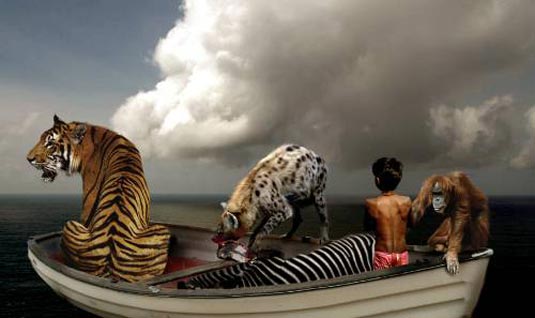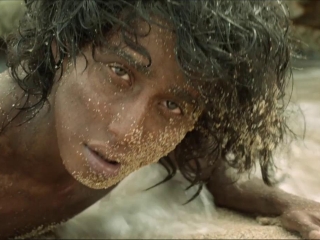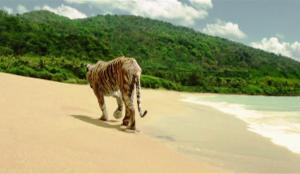
When I saw the trailer for Life of Pi, I knew I had to see it. The film is based on a book which I haven’t personally read, so I had no prior understanding of the source, and no expectations. I was just enthralled by the elegant elemental imagery; a boy alone, a boat, beautiful water, and a regal tiger.
What appears to be a very simple story actually abounds with themes, symbolism, interpretations and imagery. I will dedicate a future entry to attempting to unpick my personal interpretations of this film, but for now, to simply review it, I will just explain that a solid premise is actually a rabbit hole into questioning and meaning, littered with great forethought and intelligence. The story is the vessel through which this giant incomprehensible truth is channelled.
What surprised me about the Life of Pi was that I was expecting a colourful, bright, fantasy film. Something like Narnia perhaps. But Life of Pi is a blurring of the fantastical and the macabre.

Pi is a young boy named after a French swimming pool, growing up on his parent’s zoo in Pondicherry. The times are changing and his family must relocate to Canada. As they sail the waters reluctantly to their new life, the ship inexplicably sinks and Pi finds himself orphaned, the lone survivor on a life boat upon which dwell a zebra with a broken leg, a wise, mournful orang-utan and a hysterical hyena. Nature, the unstoppable force that it is, abounds even on the small life boat, and Pi soon finds himself alone with just a Bengal tiger named Richard Parker for company.
As they flounder in the waters, Pi learns to navigate the waves, fish and keep himself mentally amused and physically alert through a process of trial and error and survival provisions. He segregates himself from Richard, initially fearful and mistrusting of him, but the two form a bond and although Pi is never able to tame the wild beast, he is able to train and utilise him so that they are both able to survive together on the boat.

Pi acknowledges that Richard brings out the best in him. His fear of him keeps him alert and tenacious whilst the small duties of care he must undertake to keep Richard alive enthuse him with purpose which gives his otherwise listless days meaning.
Pi and Richard find themselves on a beautiful island which nourishes them by day but turns carnivorous at night. Understanding that they are unable to dwell on the island eternally for fear of what would become of them, Pi returns to the waters. When he finally returns to dry land, Richard leaves him, and Pi finds himself returned to civilisation.

Years later, as Pi tells his tale to an aspiring, but stifled novelist, he tells a second version of the tale. This one rebuffs the idea of surviving animals and mysterious, uncharted islands, and instead tells a tale of barbarism, murder and cannibalism out on the open waters, with the animals stepping in to depict their human counterparts in the initial tale. In this tale, there is no tiger. Instead Richard Parker is the animalistic id of Pi himself, who must do whatever necessary to survive. As Pi admits, hunger (or any primal urge) when unsatisfied, brings out the monstrosities within a man and tempts him to perform acts and deeds that he would find hard to align with his moral, civilised self.
Pi explains that it is up to the author (and the audience) to decide for themselves which story they prefer, and also which story they believe, indicating that preference and belief are not one and the same. The author was told that Pi’s story could help him believe in God, but Pi dismisses this.

The telling of the two stories, one hopeful, near implausible but fantastic, and the other horrifying, bleak and nihilistic can be representative of many things but primarily they represent a man living with religion, and a man living without religion.
Beyond the stunning CGI, and the worthwhile 3D effects (some films are made for 3D and this is one of them), there is a powerful juxtaposition of how humanity perceives the world around it.
Are we here because of a divine, magical, almost unbelievable miracle that makes anything possible? Or do we attribute stories and imagery to a hostile, nasty world in an attempt to survive its nonsensical cruelty?
Whichever story you believe, this is a film that will have you running around with questions, and a mind littered with symbols, themes, images and interpretations, desperate for answers.
In my opinion this film is a work of genius for its interpretation of a story that succinctly and intelligently at its heart depicts mans relentless confusion at his own existence and the myriad of explanations, beliefs and faiths we have encountered or invented in order to make life and the sufferings we endure bearable.
Please keep an eye out for my more in depth review of this film.

No comments:
Post a Comment